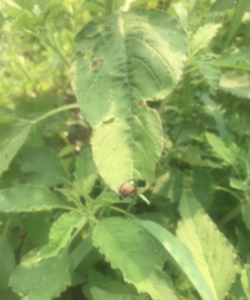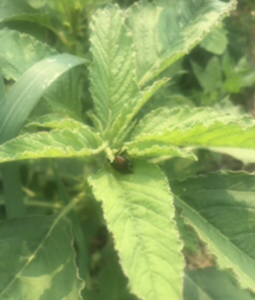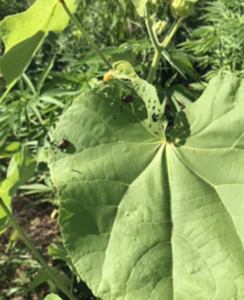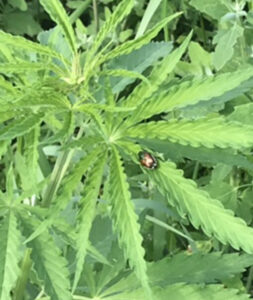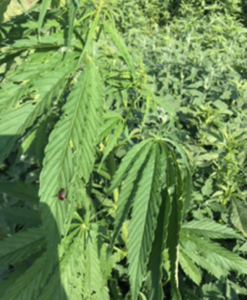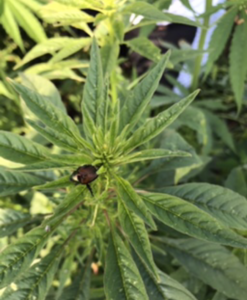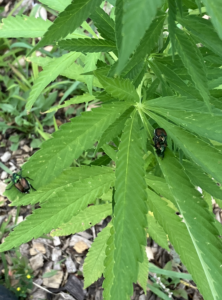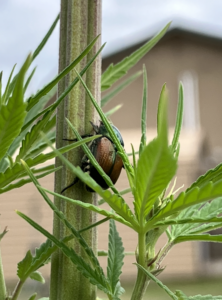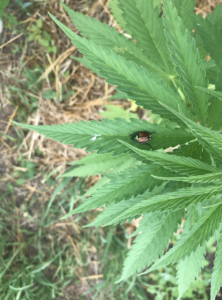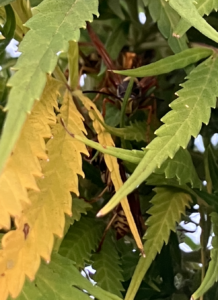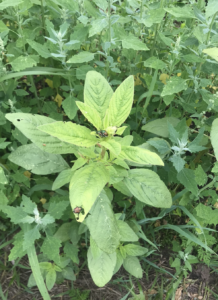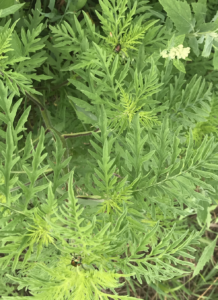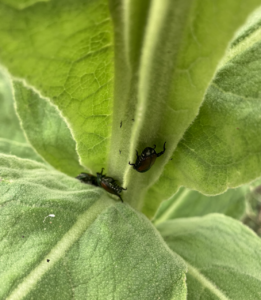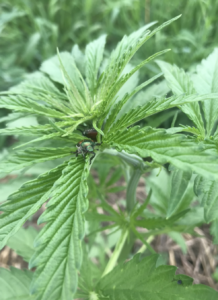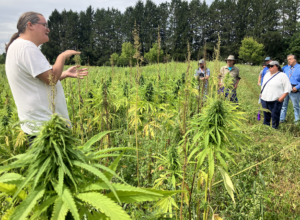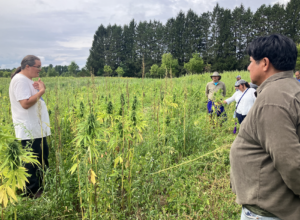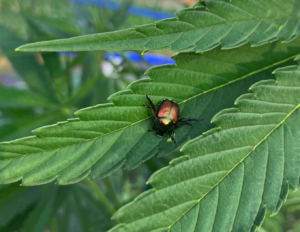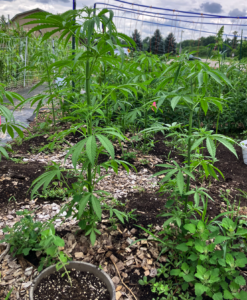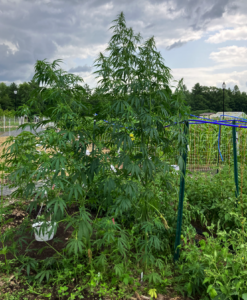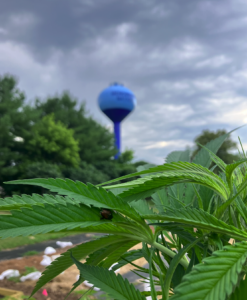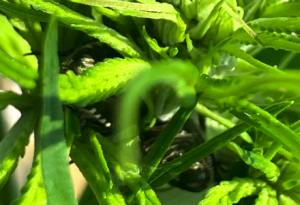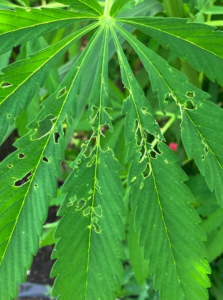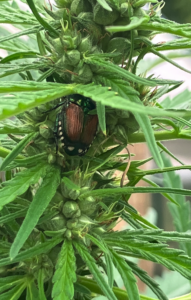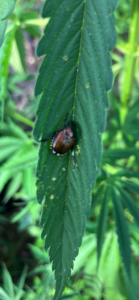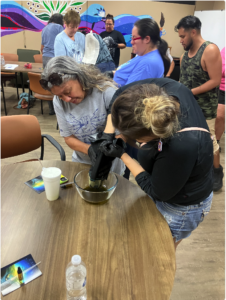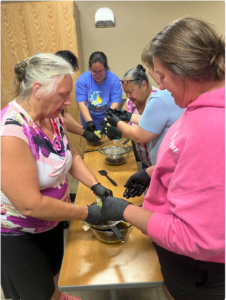Final report for FNC21-1274
Project Information
Our farm is part of a community controlled land on the Menominee Indian Reservation. We have three (3) acres we care for on this land and grow industrial hemp for fiber and grain purposes. Prior to receiving this grant, we worked on building up the organic matter in the soil as the majority of the land we work on is sand. We brought in compost soil to provide a layer of organic matter to a portion of our field for the past two growing seasons. This past year, we worked in collaboration with the Menominee Tribal Department of Community Development to help us conduct controlled burns on our three acres. Our hope was to increase the organic matter in our field, but the results provided only minimal organic matter. Menominee people have utilized controlled burns on land for centuries and it is used in our forest to boost soil fertility. While the controlled burn did not produce the results we intended, we hope to learn from the lesson in 2021 and prepare for future controlled burns to increase organic matter in our soil.
In the fall of 2022, our community controlled land welcomed home a herd of bison from the Intertribal Buffalo Council. Ten bison were transported to the farm and will roam the acres to feed on native grasses. When the bison arrived on Menominee a snowstorm followed. The long term goal of the bison is to grow the herd, feed our people, and replenish the land with healthy organic soil.
The 2023 growing season we focused our research at the College of Menominee Nation (CMN). CMN is the first location we observe the Japanese Beetles on the hemp plants. The land on CMN is an agricultural research station used by the faculty, staff, students, and the Sustainable Development Institute. The research station is on the border of the Menominee Reservation and has been used for agriculture purposes since the tribe’s treaty with the federal government. The last 10 years the land has been in control of the Menominee Tribe and cared for by other farmers as well as CMN.
Pests and diseases affect our agricultural practices every growing season. The core research of this grant proposal will revolve around our observational research on the hemp grain variety, X59. During the 2020 growing season, our observational research found a large amount of Japanese Beetles clustered around the hemp grain variety, X59, as it grew throughout the season. What was interesting is the Japanese Beetles flocked to the X59 more so than our other varieties. With hemp being a new crop available to farmers in our area, the normal routine to get rid of pests is through the utilization of pesticides. The Integrated Pest Management (IPM) research that will be done through this grant will utilize sustainable practices to observe what, if any, change occurs to the Japanese Beetle infestations on X59 when we apply different non-chemical solutions. This research, if proven effective, will educate future hemp grain farmers on what to do if Japanese Beetles infest your crop and provide an environmentally friendly IPM system to deal with this revitalized agricultural industry in the United States.
- Plant a large research plot of Hemp varietal, X59 to study the negative effects of a Japanese Beetle infestation.
- Identify which sustainable IPM method works best to mitigate Japanese Beetle or other pest infestation.
- Teach observational research to another beginning farmer.
- Share findings through field days, feasibility study, and conference presentation.
Cooperators
- (Researcher)
- (Educator)
- (Researcher)
- (Researcher)
Research
The research project will involve a 1 acre plot to conduct observational research and carry out our sustainable integrated pest management (IPM) methods. We plan to plant the hemp grain variety, X59, due to our observational analysis during the 2020 growing season of a Japanese Beetle infestation. We want to plant 1 acre of X59 to understand a Japanese Beetle infestation on a large tract of land compared to a small research plot. This will help quantify the data and hopefully develop a formula for farmers to understand the time it takes to deal with Japanese Beetles using a sustainable IPM method instead of pesticides. The data gathered from this plot will be analyzed to understand the effects of sustainable IPM methods and their effectiveness in the field.
Site Preparation:
We tilled and covered 1/4 acre with top soil for the research plot: six (6) dump trailers full of top soil and 12 hours to spread evenly to cover 1/4 acre. Originally, we planned for one (1) acre, but with the increase in fuel costs we had to scale back. We planted the first full week of June. X-59 is fast growing and the seed matures in less than 120 days. When planted with ample time before the summer solstice, X-59 performs the best with first emergence and growth compared to other seed varieties. Keep in mind the Japanese beetle begins to show at the end of June/beginning of July. We also let milkweed and other native plants grow along the hemp plants to study our observation from the previous growing season. Once we noticed the first Japanese beetle on the X-59 plants we implemented our IPM practices. We walked along the rows and knocked off the beetles into 5-gallon buckets. We noted it took us 10-15 minutes to check the plants and knock off any beetles we found. If we were to quantify our IPM practice on one (1) acre, it would take one-two people to cover the entire acre in 45-60 minutes.
The 2023 growing season and our final year of research provided us with a conclusion to the original hypothesis--whether Japanese beetles flock to the hemp grain variety, X-59, and the best sustainable methods for Integrated Pest Management (IPM). As we reported in 2022, IPM with a five (5) gallon bucket and swipe the beetles into the bucket with a Castile soap water solution. We found out it could take less than a hour (45 minutes) to cover an acre of hemp with this method--even less time if you have more than two people to help. In 2022 and 2023, we used the BeetleBeGone, is the first Bacillus thuringiensis galleriae (btg) bio-insecticide to control adult beetles and larva, based on the information provided by company Growitnaturally who produces the product. This sustainable product is effective in mitigation of the Japanese Beetle. We mixed the product in the soil this past fall and will monitor in 2024 to see the effects on the larva that emerges in June.
2021 Updates:
During the 2021 growing season, we moved our X-59 hemp grain variety to a different location from the 2020 growing season for two reasons: 1) the one acre we planned to plant could not fit in the area we had originally grown in. We moved the planned one acre site to a larger location; 2) we wanted to observe whether the Japanese beetle was particularly attracted to the X-59 hemp grain variety or just goes after any type of hemp variety. We worked with the Menominee Tribal Department of Community Development to conduct a controlled burn on the planned one acre site in the spring of 2021. We were successful in burning the control area without issue, but did not produce the amount of organic matter we needed to plant.
At the beginning of June, we originally intended to plant our one acre of X-59, but had to hold off on planting due to a death in the family. Per Menominee traditional customs, we had to delay our planting and handle the funeral/grief process. We missed our intended planting date for the X-59 due to this situation. As X-59 performs the best planted a couple of weeks before the summer solstice, we missed our target date for planting. We planted a smaller plot (20ft x 20ft) with the compost soil we trucked in. We observed the plants to see if any Japanese beetles arrived. We plan to grow our intended one acre plot of X-59 for the 2022 growing season.
On the original site where we grew X-59 during the 2020 growing season, we planted our seed breeding variety that we've been working on to observe during the growing season. We noticed Japanese beetles flocked to this other hemp variety and at the same amount or less as it did when we planted X-59 in 2020. We plan to continue our observational research during the 2022 growing season. We also noticed during the 2021 growing season, the Japanese beetle flocks to other plants, including sunflowers and other plants that grow naturally around our hemp crops. Originally we wanted to plant an acre of hemp and have an organic solution to mix into the soil. This organic mix would stop the Japanese beetle larva from hatching. With the delays we had during the 2021 growing season, our plan is to carry out this objective to our research in the 2022 growing season. We hope to observe what effects this might have on the Japanese beetle both at the 2020 and 2021 growing locations. Below are images of Japanese Beetles observed.
2022 Updates:
The 2022 growing season focused on IPM application and observation of Japanese beetles on the hemp plants. We had two plots for our research: one at Menikanaehkem, which is on the south central portion of the reservation, and the other one at the College of Menominee Nation, the original site of our initial research findings in 2020. We did research on both sites to 1) isolate the X-59 variety from the other hemp we are growing and 2) document our observational research to see if the Japanese beetle swarm other hemp varieties.
The results from this growing season shows the Japanese Beetles were not as prevalent at the new site compared to the College of Menominee Nation site; the first site of Japanese beetles found on the hemp plants. We changed sites to see if the beetles were only prevalent on the X-59 hemp grain crop. This is not true as the results from the past two growing seasons has shown the beetles were on all the hemp plants at the College of Menominee Nation site, not just the X-59 grain variety from the 2020 growing season. After consultation with our tribal Landscape Ecologist, Jeff Grignon, his advice was that Japanese Beetles do not cross the Wolf River. There is something about the river that deters the beetle population from traveling through the reservation, which is why they are more prevalent in the southeastern portion of the reservation, where the College of Menominee Nation is located.
The Menikanaehkem site is where we planted a large plot of the X-59 variety. We source top soil from a sustainable agriculture farmer near the reservation who we've utilized for the last three growing seasons to ensure we remain consistent in our research. We tilled and covered 1/4 acre with top soil for the research plot: six (6) dump trailers full of top soil and 12 hours to spread evenly to cover 1/4 acre. Originally we planned for one (1) acre, but with the increase in fuel costs we had to scale back. We planted the first full week of June. X-59 is fast growing and the seed matures in less than 120 days. When planted with ample time before the summer solstice, X-59 performs the best with first emergence and growth compared to other seed varieties. Keep in mind the Japanese beetle begins to show at the end of June/beginning of July. We also let milkweed and other native plants grow along the hemp plants to study our observation from the previous growing season. Once we noticed the first Japanese beetle on the X-59 plants we implemented our IPM practices. We walked along the rows and knocked off the beetles into 5 gallon buckets.
We noted it took us 10-15 minutes to check the plants and knock off any beetles we found. If we were to quantify our IPM practice on one (1) acre, it would take one-two people to cover the entire acre in 45-60 minutes. This would depend on the extent on the infestation on the plants, the practices used -- whether buckets or Beetlebegone organic spray -- and the individuals' application of IPM. The time it takes to apply IPM is reduced the more hands are available to walk the field.
In July, we observed a massive amount of bumblebees on the male hemp plants. The bees were gathering all the pollen from the males. At one time, you could see at least 10 bumblebees on the plant. We found this observation to be important because when hemp is planted on a large scale and there is no sustainable IPM, the only course of action is to spray chemicals. Sustainable agriculture farmers should understand that there are many insects, including bumblebees and ground-bees, that enjoy being on hemp plants which serve as a food source.
The College of Menominee Nation site is where the other hemp varieties were planted. This site also houses the college's agricultural research and community garden with livestock. A variety of vegetables, flowers, herbs, and spices are grown in this area near the hemp plants. This growing season, the college researchers decided to use Japanese beetle tents to deter the large population in our research plots. There were a massive amount of beetles in every tent we set up. This required us to clean out each tent at least once a week to ensure effectiveness. The tents are effective at deterring beetles, but we still had a fair amount of beetles. We applied the bucket practice on this plot for the remaining beetles that we found on the hemp plants.
Through our observations, we saw Japanese beetles en mass on mullein plants nearby our hemp plot. There were other native plants the beetles flocked to during the growing season. A fascinating discovery was the sighting of yellow jackets hanging out in the hemp flowers in September. We were unsure of why the yellow jackets were in hemp flowers and it seemed as though they burrowed deep into the flowers. There was no sign of other insects. This is the first time we have witnessed the yellow jackets in the hemp plants in the six years of research. More observation and research will need to be completed to understand the effects yellow jackets have on hemp.
The 2023 growing season we will focus on the College of Menominee Nation site for our final data collection using the same pest mitigation tools we used during the 2022 growing season. This is because we have been growing on the same plot for the past three growing seasons and hemp should not be grown on the same location past two growing seasons, per information obtained from the National Agriculture Library Special Collections. Our plan this growing season is to move the hemp research plot further into the field away from the other research plots to see if planting hemp away from the other vegetables/spices will make a difference. We plan to document our research via videos of our process and the Japanese beetles on the hemp plants.
Video of Yellow Jacket: https://youtube.com/shorts/1-DEfRxIYvU?feature=share
2023 Update:
The 2023 growing season had our final research conducted at the College of Menominee Nation (CMN). We initially planned to move our research plot closer to the tree line of the property next to CMN. Unfortunately the land was already allocated for conservation purposes. In early May, Violet Bia, Garden Manager for the community garden, found two (2) volunteer hemp plants by the greenhouse. As our original plot from 2020 near the service road to the CMN's Sustainable Development Institute had hemp grown for past two (2) years and reached its limit. Hemp can be grown on the same parcel of land for up to two (2) years before being rotated out for another crop based on Lyster Dewey's USDA hemp production records from the National Agricultural Library. We moved the research plot closer to the greenhouse operated by Continuing Education at CMN. Violet, the farmer who oversees the community garden has been intrigued by the hemp research offered the parcel of land to us where the volunteer hemp was found, her support, and student researchers. We planted near the two volunteer hemp plants and prepared the soil with fresh top soil from the soil farmer we've worked with for the past three years.
We planted both X-59 and the variety, Coyote Otter 15, being developed in collaboration with CMN on an Indigenous Permaculture designed garden . The research plot was built using mounds and mulch was filled in where the crevices formed around the mounds. We shaped the mulch into a lightning bolt as can be seen on second photo from left. Our observation through this growing season reconfirmed the Japanese Beetles are not particular to a certain hemp variety and will flock to any hemp being grown. The destruction the beetles can cause is leaf foliage damage as shown below. Further, Japanese Beetles have been shown to mate on hemp plants and should be evaluated on the negative effects for nearby crops known to be impacted significantly by the beetle infestations.
This growing season our methods shifted from the previous two growing seasons. In the previous growing seasons, we waited until the Japanese Beetle show up on the plants and begin our integrated pest management (IPM). This year we started our IPM when the larva began to emerge from the soil. Best method is to remain vigilant during the month of June with the grubs we found on the soil beds. Violet and the student researchers hand-picked the grubs from the soil when visible. This process showed us a difference in the number of beetles on the plants as the season progressed. We found this method the most effective and put the remaining BeetleBeGone product in a section of our research plot to see if we have less larva in June 2024.The videos we edited from the previous growing seasons will be released at the beginning of 2024 growing season to educate other farmers on the Japanese Beetle sustainable IPM.
As the season came to a close, our farm group had a meeting to debrief on the growing season. I posed a question to the group about the work we did to reduce the Japanese Beetles and if anyone thought there were other factors that contributed to the decrease in the beetle infestation. Violet mentioned the 2023 growing season was the first year we did not plant pole beans on the farm. The last three growing seasons Japanese Beetles flock to the pole beans and decimated the crop each year. This was an interesting observation from one of the research farmers in our group.
We have previously noted plants growing near the hemp in past growing seasons and this year we learn about the pole beans being an attraction to Japanese Beetles. One of the biggest takeaways for us in Menominee is we need to be cognizant of the plants and crops we grow in our field. Future sustainable agriculture farmers should consider and know which plants and/or crops attract the beetles. This will help deter the decimation the beetles can do to a field, plant, or crop.
The last three years of research and observational analysis of our hemp field open our eyes to other insects and frogs that enjoy being around the hemp. Even predators such as the yellow jackets who burrow into the hemp flower at peak season to gather sugar for the winter. There needs to be more research on top of the current work on bee populations and hemp to grasp the positive effects of hemp production in an ecosystem.
Educational & Outreach Activities
Participation Summary:
Due to COVID-19 Executive Orders passed by the Menominee Tribe, we could not organize a field day. We did have one-on-one conversations with beginning farmers interested in producing hemp in Northeast Wisconsin and those who wanted to learn more about our farming practices. Our plan for the 2022 growing season is to hold a field day and do online videos of our process. We want to organize a co-event with the College of Menominee Nation's Department of Continuing Education and Sustainable Development Institute to promote the Hemp Supply Chain grant work the college has undertaken this past year. We hope the 1 acre of X59 we grow organically will be used to feed the trout in the aquaculture project tied to the grant.
2022 Update
In August 2022, we hosted a group from Wisconsin Tribal Conservation Advisory Council for a visit to Menikanaehkem. Over 35 individuals from all 11 tribes in Wisconsin along with the state department of natural resources were among the group. The folks from Menikanaehkem toured the grounds to check out the new NRCS high tunnel that was installed, learn more about our controlled burn practices, and walk the hemp field. We were able to educate the group on our research on Japanese beetles through SARE and answer questions on hemp production. A couple of tribal officials want to grow hemp and we plan to help them.
In early December, we traveled to the Intertribal Agriculture Council's Annual Meeting in Las Vegas, NV to present on our research findings with conference participants. We had over 65 conference participants in our presentation and standing room only. Our presentation covered the work we are doing at the College of Menominee Nation, the SARE grant, and a live demonstration on how to process hemp with a hand brake. We offered support to anyone who plans to pursue a SARE grant for their own research. The audience was engaged, interested, and asked various questions about hemp. After the presentation, many conference participants and organizers came up to say how much they learned from our work.
2023 Update
We had three different opportunities to educate students and farmers on our research. During the spring and fall seasons, the University of Cincinnati invited us to speak in their Introduction to Cannabis course. The students were fascinated by the research with the Japanese Beetles and our breeding work with our hemp variety, Coyote Otter 15. This past August, the College of Menominee Nation invited us into their Hemp Training Seminar sponsored by the National Institute for Food and Agriculture (NIFA) Hemp Supply Chain grant. We were able to educate 16 farmers on our sustainable Integrated Pest Management (IPM) and give a tour of the research plot. We identified the leaf damage caused by the Japanese Beetle and educated the farmers about the best practices to deal with the beetle infestations. The farmers enjoyed being in the research plot and standing next to the tall hemp plants. Violet Bia, one of our fellow research farmers pictured below on the far right, talked about caring for the hemp plants this growing season and the larva mitigation in the early part of the season. After we toured the hemp research plot, we went back to the classroom to make various value added hemp products from cold-pressed hemp seed oil and hemp CBD flower.
Learning Outcomes
Please refer to the research results and discussion section for information regarding lessons learned.
